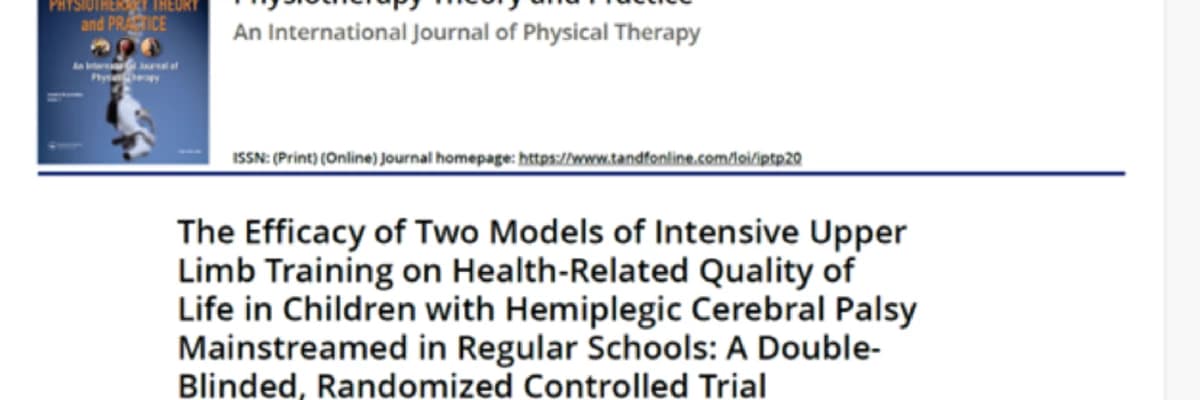The Efficacy of Two Models of Intensive Upper Limb Training on Health-Related Quality of Life in Children with Hemiplegic Cerebral Palsy Mainstreamed in Regular Schools: A Double- Blinded, Randomized Controlled Trial
Background: Children with hemiplegic cerebral palsy (CP) are at risk of reduced upper limb
function and poorer quality of life than their typically developing peers. Although upper limb
impairments have potential negative impact on the health-related quality of life (HRQOL) in
children with hemiplegic CP, the efficacy of upper limb rehabilitation approaches aiming to
improve upper limb impairments on HRQOL has not been adequately investigated.
Objective: This study compares the efficacy of two modes of activity-based upper limb rehabilitation (modified constraint-induced movement therapy [mCIMT] and bimanual training [BIM]) on HRQOL outcomes in children with hemiplegic CP mainstreamed in regular schools.
Methods: Thirty children with hemiplegic CP aged between 7 and 11 years (mean age
8.53 ± 1.54 years) who had functional ability levels of I–III according to the Manual Ability
Classification System (MACS), Gross Motor Classification System (GMFCS), and Communication Function Classification System (CFCS) were randomly assigned to receive mCIMT or BIM training.
Result: Both mCIMT and BIM yielded statistically significant improvements in all HRQOL domains immediately after the 10-week interventions (P < .001), which were retained at 16 weeks.
Conclusion: While there were some differences in the intervention effects, both of these upper limb rehabilitation approaches based on intensive unimanual or bimanual activity may be beneficial for improving perceived life satisfaction related to physical activity, general mood, family, friends, and school among children with hemiplegic CP mainstreamed in regular schools

Özgeçmiş: Hemiplejik serebral palsili (SP) çocuklar, normal gelişim gösteren akranlarına göre üst ekstremite fonksiyonlarında azalma ve daha düşük yaşam kalitesi riski altındadır. Üst ekstremite
bozuklukları hemiplejik SP'li çocuklarda sağlıkla ilgili yaşam kalitesi (HRQOL) üzerinde potansiyel olumsuz etkiye sahip olsa da üst ekstremite bozukluklarını iyileştirmeyi amaçlayan üst ekstremite rehabilitasyon yaklaşımlarının HRQOL üzerindeki etkinliği yeterince araştırılmamıştır.
Amaç: Bu çalışmada, normal okullarda kaynaştırılan hemiplejik SP'li çocuklarda iki aktivite temelli üst ekstremite rehabilitasyon yönteminin (modifiye kısıtlamaya bağlı hareket terapisi [mCIMT] ve bimanuel eğitim [BIM]) HRQOL sonuçları üzerindeki etkinliği karşılaştırılmıştır.
Yöntemler: El Becerisi Sınıflandırma Sistemi (MACS), Kaba Motor Sınıflandırma Sistemi (GMFCS) ve İletişim Fonksiyonu Sınıflandırma Sistemine (CFCS) göre fonksiyonel beceri düzeyleri I-III olan, yaşları 7 ila 11 arasında değişen (ortalama yaş 8,53 ± 1,54 yıl) 30 hemiplejik SP'li çocuk mCIMT veya BIM eğitimi almak üzere rastgele atanmıştır.
Sonuçlar: Hem mCIMT hem de BIM, 10 haftalık müdahalelerden hemen sonra tüm HRQOL alanlarında istatistiksel olarak anlamlı iyileşmeler sağlamış (P < .001) ve bu iyileşmeler 16. haftada da korunmuştur.
Etiketler
Spastik serebral palsiHemipleji tedavisi
